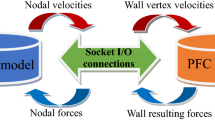Abstract
The authors present results on the use of the discrete element method (DEM) for the simulation of drilling processes typical in the oil and gas exploration industry. The numerical method uses advanced DEM techniques using a local definition of the DEM parameters and combined FEM-DEM procedures. This paper presents a step-by-step procedure to build a DEM model for analysis of the soil region coupled to a FEM model for discretizing the drilling tool that reproduces the drilling mechanics of a particular drill bit. A parametric study has been performed to determine the model parameters in order to maintain accurate solutions with reduced computational cost.
















Similar content being viewed by others
References
Defyer DPC Series. Weatherford International Ltd., Houston, (2005) 4674.02
Carbonell JM, Abedrabbo N, Celigueta MA, Oñate E (2015) A 3D beam element for analysis of the drill string mechanics in boreholes. Research Report CIMNE, PI411, Barcelona
Donzé F, Richefeu F, Magnier S (2009) Advances in discrete element method applied to soil, rock and concrete mechanics. Electron J Geotechol Eng 8:144 Special volume, Bouquet
Fakhimi A, Villegas T (2007) Application of dimensional analysis in calibration of a discrete element model for rock deformation and fracture. Rock Mech Rock Eng 40(2):193–211
Hentz S, Daudeville L, Donzé F (2004) Identification and validation of a discrete element model for concrete. J Eng Mech 130(6):709–719
Hsieh Y-M, Li H-H, Huang T-H, Jeng F-S (2008) Interpretations on how the macroscopic mechanical behavior of sandstone affected by microscopic properties revealed by bonded-particle model. Eng Geol 99(1):1–10
Huang H (1999) Discrete element modeling of tool-rock interaction. Ph.D. Thesis, University of Minnesota
Labra C, Rojek J, Oñate E, Zarate F (2008) Advances in discrete element modeling of underground excavations. Acta Geotech 3:317–322
Labra C, Oñate E (2009) High-density sphere packing for discrete element method simulations. Commun Numer Methods Eng 25(7):837–849
Labra C, Rojek J, Oñate E, Zárate F (2009) Advances in discrete element modelling of underground excavati ons. Acta Geotech 3(4):317–322
Labra C (2012) Advances in the development of the discrete element method for excavation processes. Ph.D. Thesis. Technical University of Catalonia, UPC
Oñate E, Rojek J (2004) Combination of discrete element and finite element methods for dynamic analysis of geomechanics problems. Comput Methods Appl Mech Eng 193:3087–3128
Oñate E, Labra C, Zárate F, Rojek J (2011) Modelling and simulation of the effect of blest loading an structure using an adaptive blending of discrete and finite element method. In: 3rd International week on risk analysis, dam safety, dam security and critical infrastructure management. Valencia, 17–18 Oct
Oñate E, Zárate F, Miquel J, Santasusana M, Celigueta MA, Arrufat F, Gandikota R, Khardar, Ring L (2015) A local constitutive model for the discrete element method. Application to geomaterials and concrete. Comput Part Mech 2(2):139–160
O’Sullivan C, Bray J (2004) Selecting a suitable time step for discrete element simulations that use the central difference time integration scheme. Eng Comput 21:278–303
Potyondy D, Cundall P (2004) A bonded-particle model for rock. Int J Rock Mech Min Sci 41(8):1329–1364. Rock Mechanics Results from the Underground Research Laboratory
Rojek J, Oñate E, Zarate F, Miquel J (2001) Modelling of rock, soil and granular materials using spherical elements. In: 2nd European conference on computational mechanics ECCM-2001, Cracow, 26–29 June
Rojek J, Oñate E (2007) Multiscale analysis using a coupled discrete/finite element model. Interact Multiscale Mech 1(1):1–31
Rojek J, Oñate E, Kargl H, Labra C, Akerman J, Restener U, Lammer E, Zarate F (2008) Prediction of wear of roadheader picks using numerical simulations. Geomech und Tunn 1:47–54
Rojek J, Labra C, Su O, Oñate E (2012) Comparative study of different micromechanical parameters. Int J Solids Struct 49:1497–1517
Tavarez FA, Plesha ME (2007) Discrete element method for modelling solid and particulate materials. Int J Numer Methods Eng 70(4):379–404
Tran VT, Donzé F-V, Marin P (2011) A discrete element model of concrete under high triaxial loading. Cem Concr Compos 33:936–948
Zárate F, Oñate E (2015) A simple FEM-DEM technique for fracture prediction in materials and structures. Comput Part Mech 2(3):301–314
Acknowledgments
Financial support for this work was provided by Weatherford. The authors thank Dr. C. Labra for many useful discussions. The numerical results presented in this work have been obtained with the code DEMPACK developed at CIMNE (www.cimne.com/dempack).
Author information
Authors and Affiliations
Corresponding author
Rights and permissions
About this article
Cite this article
Ubach, P.A., Arrufat, F., Ring, L. et al. Application of an enhanced discrete element method to oil and gas drilling processes. Comp. Part. Mech. 3, 29–41 (2016). https://doi.org/10.1007/s40571-015-0080-5
Received:
Revised:
Accepted:
Published:
Issue Date:
DOI: https://doi.org/10.1007/s40571-015-0080-5




